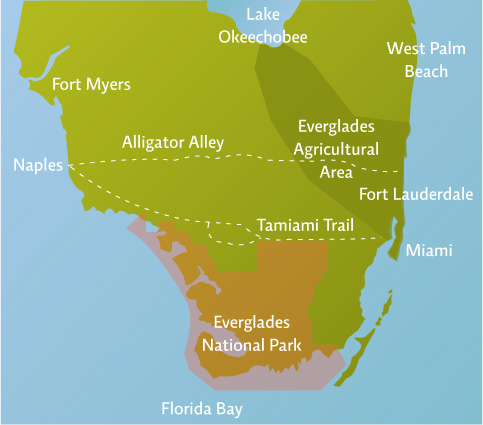Human alterations have changed the face of the Everglades.
South Florida once provided an ideal breeding ground for these amazing but picky birds. Before giving way to a hodgepodge of resorts, sugar plantations, and dense urban centers, the region was defined by an uninterrupted web of natural ecosystems, collectively known as the Everglades. Marshes, prairies, swamps, and forests stretched across some 10,000 square kilometers (4,000 square miles) of land. Each distinct community was connected by the same slow-moving water, which began at the southern edge of Lake Okeechobee and flowed south for 160 kilometers (100 miles) before emptying into the Florida Bay. The glacial pace of this water (it can take months or even years for a given eddy to travel from lake to bay) across such a broad, shallow expanse (100 kilometers [60 miles] wide, and in some places just a few centimeters or inches deep) is known as sheet flow. The Everglades’ nickname, “River of Grass,” comes from the image of sheet flow through the region’s iconic sawgrass marshes.

It was here that wood storks flourished. In the 1930s, an estimated 15,000 to 20,000 pairs nested throughout the southeastern United States—largely in South Florida, where foraging grounds were ideal. And because their plain black-and-white plumage was not lovely enough to attract bird hunters collecting feathers for fashionable ladies’ hats, the storks thrived even as other wading bird stocks were decimated.
But it was not long after they first discovered the Everglades that American explorers began hatching plans to drain and then develop them. Swamps and muddy rivers choked with grass were seen as having no inherent value. “From the middle of the 19th century to the middle of the 20th, the United States went through a period in which wetland removal was not questioned,” says University of Florida geographer and historian Christopher Meindl. “In fact, it was considered the proper thing to do.” The Central and Southern Florida Project, authorized by Congress in 1948, set out to systematically drain the Everglades. And over time, a vicious new cycle was established: Humans would drain the swamps and replace them with towns and cities, and then a rash of floods would prompt more complete drainage (under the mandate of flood control and prevention), which would in turn be followed by even more development (on the newly drained land).
As the human population swelled in the region, water that once fed swamps and marshes was rerouted to the faucets of burgeoning developments. And as water levels changed, becoming deeper in some areas and completely disappearing in others, the total wading bird population plummeted—by 90% between the 1930s and 1990s.